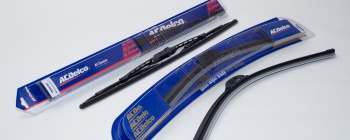
A safe opportunity in more ways than one.
Whilst the absence of a real cold snap so far this winter has rendered battery sales relatively flat, never before have drivers had to use their windscreen wipers as much as they have. So it is against this backdrop that leading aftermarket brand, ACDelco, is urging the industry to educate drivers of the need to not just regularly check their blades but change them in the process. It’s a win-win situation, one where suppliers get the chance to attract an additional revenue stream, with drivers benefiting from replacing what is, and always has been, a safety critical component, albeit one that is often overlooked.
As ACDelco’s UK and European Director, Lee Quinney states: “The potential for wiper blades should be a safe opportunity for those operating in the automotive aftermarket, however research has long indicated that both suppliers and manufacturers are missing a trick and have been for longer than anyone cares to remember. Indeed past claims have indicated that the market for wiper blades has the potential to double, if only motorists could be made to realise just how important a safety critical component they are. In short, they haven’t, despite the potential still being out there.”
So what needs to be done? Wipers, as with many other automotive components, have benefited from ongoing product development. Take the introduction of flat wiper blades that are today probably found on the top twenty cars sold in Europe. The development of products such as flat blades has been driven by the need for improved product quality, enhanced performance characteristics, comfort and aesthetics.
In essence, given the fact that wiper blade technology has moved on, and for the better, surely the responsibility for grasping the opportunity that continues to prevail rests with the marketeers? ACDelco believes the time is now right to focus on a number of clear, key messages that need communicating to drivers if any growth potential is to be maximised.
REGULAR CHECK-UPS – Whilst drivers should be encouraged to include them on a weekly checklist, encouraging them to inspect their wipers ahead of departing on a summer holiday or long journey, particularly if children or passengers are in the car, is an absolute must.
SAFETY FIRST - Rain, snow, insects, dirt, grime, poor air quality and even bird deposits – a car’s wiper blades have a lot to cope with. And it’s vital they do. Unless a windscreen is clear, the driver is in grave danger to him/herself and others. Drivers should be educated to ignore them at their peril, as poor, impaired performance leads to a hazardous reduction in visibility.
INCREASED VISBILITY – Being a highly visible product, keeping them tucked away in the back of a garage workshop or retail outlet is far from ideal. They should be visible to the consumer at all times and accessible. Indeed what’s the harm in encouraging vehicle owners to include a spare set of wiper blades in their car?
BREAKING THE LAW – If concerns over the driver’s own safety, that of passengers and other road users doesn’t strike a chord, alerting them to the dangers of contravening the law may well do so. Research again points to the fact that a high percentage of vehicles globally could have seriously worn and potentially illegal blades, and that 98% of drivers may be unaware that they could be breaking the law.
A SERVICE CONSUMABLE – In theory, the wiper blade has always been a serviceable item. And whilst any mechanic worth his/her salt knows what a split, cracked or perished wiper blade looks like, they should be checked not just during servicing but whenever a vehicle is on garage’s premises.
DON’T FORGET THE REAR GUARD – Wiper blades do not exist solely to improve visibility through the front windscreen. Almost all cars have rear wiper blades and many others feature them equipped on headlight clusters. Vehicle owners should be constantly made aware of this and encouraged to check them regularly.
ENSURE HELP IS AT HAND – If research indicates that 60% of drivers cite the nuisance associated with fitting wiper blades as a reason for not doing so, stockists should be encouraged by manufacturers to offer this service as a must. Indeed an increasing number of pro-active automotive component specialists now offer a fitting service and this should be encouraged if the real potential for wiper sales growth is to be realised.
So there you have it. The challenge facing wiper blade manufacturers across the globe is one of implementing strategies effective at changing consumer habits. It will be those organisations and their partners who are successful in helping the consumer see the light by making them appreciate the need to regularly check and replace wiper blades that will win through in the end.
KEY FACTS:
• The average use of a wiper blade is universally recognised as being six months.
• The average wiper blade wipes the windscreen over one million times a year, travelling 800 miles in the process.
• Wipers suffer from as much wear and tear in the summer as in winter.
• Worn wiper blades can result in screen vision being reduced by up to 30%
• It is believed that some 20% of all accidents may be caused as a result of poor visibility.
• Wiper blade replacement periods vary enormously from country-to-country. Whilst in some parts of the world it can be as low as every 1.3 years, in others it can rise to around four years.


 Click here to open the navigation menu
Click here to open the navigation menu